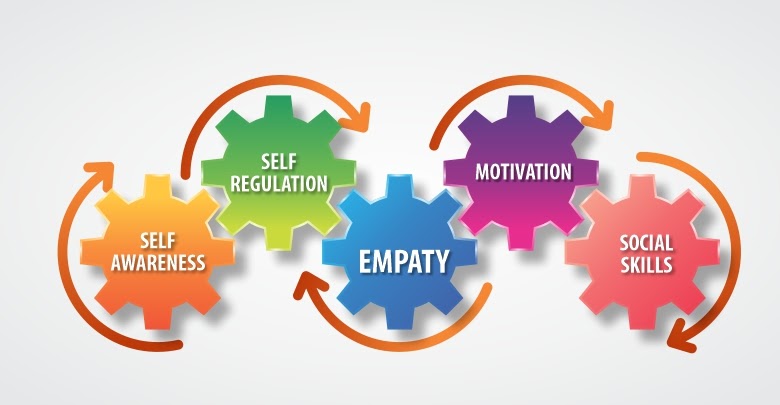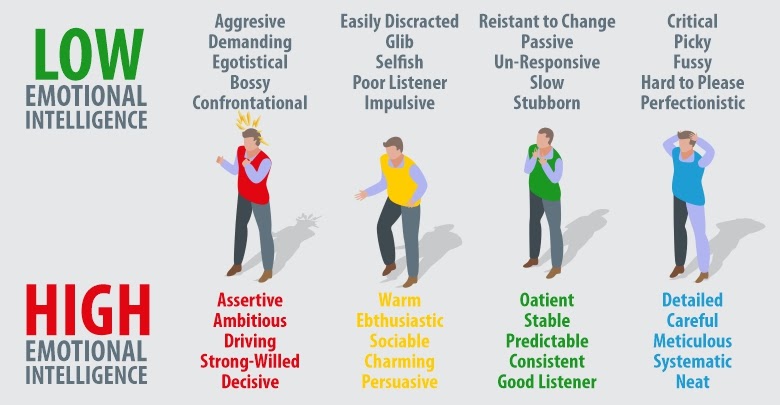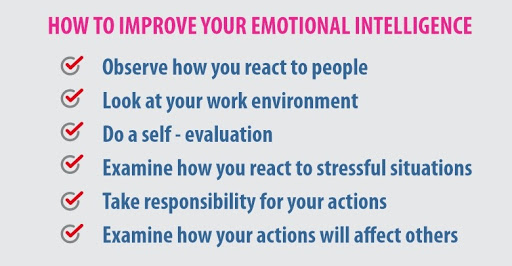Emotional Intelligence
Emotional Intelligence is about being smarter with feelings. More aware. More intentional. More purposeful.

Emotional intelligence (EI) refers to the ability to perceive, control, and evaluate emotions. Some researchers suggest that emotional intelligence can be learned and strengthened, while others claim it’s an inborn characteristic.

Description:
The Emergence of Emotional Intelligence:
It was not until 1985, when in a doctoral dissertation by Wayne Payne that the term, “emotional intelligence” was first used. In 1987, an article published in Mensa Magazine, Keith Beasley uses the term “emotional quotient.” Some suggest that this is the first published use of the phrase, although Reuven Bar-On claims to have used the term in an unpublished version of his graduate thesis. In 1990, psychologists Peter Salovey and John Mayer publish their landmark article, “Emotional Intelligence,” in the journal Imagination, Cognition, and Personality.
In 1995, the concept of emotional intelligence is popularized after the publication of psychologist and New York Times science writer Daniel Goleman’s book Emotional Intelligence: Why It Can Matter More Than IQ. The topic of emotional intelligence has continued to capture the public interest since and has become important in fields outside of psychology including education and business.

Components
Salovey and Mayer proposed a model that identified four different levels of emotional intelligence, including emotional perception, the ability to reason using emotions, the ability to understand emotion, and the ability to manage emotions.

Perceiving emotions: The first step in understanding emotions is to perceive them accurately. In many cases, this might involve understanding nonverbal signals such as body language and facial expressions.
Reasoning with emotions: The next step involves using emotions to promote thinking and cognitive activity. Emotions help prioritize what we pay attention to and react to; we respond emotionally to things that garner our attention.
Understanding emotions: The emotions that we perceive can carry a wide variety of meanings. If someone is expressing angry emotions, the observer must interpret the cause of the person’s anger and what it could mean. For example, if your boss is acting angry, it might mean that he is dissatisfied with your work, or it could be because he got a speeding ticket on his way to work that morning or that he’s been fighting with his wife.
Managing emotions: The ability to manage emotions effectively is a crucial part of emotional intelligence and the highest level. Regulating emotions, responding appropriately, and responding to the emotions of others are all important aspects of emotional management.
These models are a perfect example of the training; so far, most of the trainers subconsciously have used some or all of the models in practice. It is good that we are putting them on paper, so they can develop themselves and have more effective training and more responsive participants.
Understanding the Five Categories of Emotional Intelligence (EQ)

- Self-awareness. The ability to recognize an emotion as it “happens” is the key to your EQ. Developing self-awareness requires tuning in to your true feelings. If you evaluate your emotions, you can manage them. The major elements of self-awareness are:
- Emotional awareness. Your ability to recognize your own emotions and their effects.
- Self-confidence. Sureness about your self-worth and capabilities.
- Self-regulation. You often have little control over when you experience emotions. You can, however, have some say in how long an emotion will last by using several techniques to alleviate negative emotions such as anger, anxiety or depression. A few of these techniques include recasting a situation in a more positive light, taking a long walk and meditation or prayer. Self-regulation involves
- Self-control. Managing disruptive impulses.
- Maintaining standards of honesty and integrity.
- Taking responsibility for your own performance.
- Handling change with flexibility.
- Being open to new ideas.
- Motivation. To motivate yourself for any achievement requires clear goals and a positive attitude. Although you may have a predisposition to either a positive or a negative attitude, you can with effort and practice learn to think more positively. If you catch negative thoughts as they occur, you can reframe them in more positive terms — which will help you achieve your goals. Motivation is made up of:
- Achievement drive. Your constant striving to improve or to meet a standard of excellence.
- Aligning with the goals of the group or organization.
- Readying yourself to act on opportunities.
- Pursuing goals persistently despite obstacles and setbacks.
- Empathy. The ability to recognize how people feel is important to success in your life and career. The more skillful you are at discerning the feelings behind others’ signals the better you can control the signals you send them. An empathetic person excels at:
- Service orientation. Anticipating, recognizing and meeting clients’ needs.
- Developing others. Sensing what others need to progress and bolstering their abilities.
- Leveraging diversity. Cultivating opportunities through diverse people.
- Political awareness. Reading a group’s emotional currents and power relationships.
- Understanding others. Discerning the feelings behind the needs and wants of others.
- Social skills. The development of good interpersonal skills is tantamount to success in your life and career. In today’s always-connected world, everyone has immediate access to technical knowledge. Thus, “people skills” are even more important now because you must possess a high EQ to better understand, empathize and negotiate with others in a global economy. Among the most useful skills are:
- Wielding effective persuasion tactics.
- Sending clear messages.
- Inspiring and guiding groups and people.
- Change catalyst. Initiating or managing change.
- Conflict management. Understanding, negotiating and resolving disagreements.
- Building bonds. Nurturing instrumental relationships.
- Collaboration and cooperation. Working with others toward shared goals.
- Team capabilities. Creating group synergy in pursuing collective goals.
How to improve your Emotional Intelligence
Interests in using and developing emotional intelligence have grown in recent years. As for a trainer here are some tips to improve some emotional skills:
Listen: If you want to understand what participants are feeling, the first step is to pay attention. Take the time to listen to what they are trying to tell you, both verbally and non-verbally. Body language can carry a great deal of meaning. When you sense that someone is feeling a certain way, consider the different factors that might be contributing to that emotion.
Empathize: Picking-up on emotions is critical, but you also need to be able to put yourself into someone else’s shoes, to truly understand their point of view. Practice empathizing with other people. Imagine how you would feel in their situation. Such activities can help you build an emotional understanding of a specific situation as well as develop stronger emotional skills in the long-term.
Reflect: The ability to reason with emotions is an important part of emotional intelligence. Consider how your own emotions influence your decisions and behaviors. When you are thinking about how other people respond, assess the role that their emotions play. Why is this person feeling this way? Are there any unseen factors that might be contributing to these feelings? How do your emotions differ from theirs? As you explore such questions, you may find that it becomes easier to understand the role that emotions play in how people think and behave.
Ask others for perspective: Often, we don’t realize that other people view us much differently than we view ourselves, and vice versa. It’s not about right or wrong; it’s simply understanding how perceptions differ, and the consequences those differences create.
By asking those close to us–like a significant other or close friend or workmate–about our interactions with them, we can learn from their perspective. For example, we could think about a specific time when we were highly emotional. Ask the other person: Did I act out of the ordinary during that time? Could you describe how?
Then, ask them to relate experiences regarding when they were going through an emotional situation.
You can ask:
How did I deal with you at that time?
Would you say I was sensitive to your feelings and emotions?
Getting the answers to these questions will help us to see ourselves more like others see us–and help us to understand others better, too. You can then use that knowledge to adjust your dealings with others.
Be observant: Armed with this newly acquired knowledge, you can now be more observant of your current emotions. Your self-reflection and what others have shared will help you to be more in tune with what you’re feeling.
If you make any new discoveries, make sure to repeat step one. You can even write down your experience; doing so will help clarify your thinking and keep you in “learning mode”.
Use “the pause”: “The pause” may be as simple as taking a moment to stop and think before we act or speak. If everyone made that a practice, imagine how much shorter emails could be, how much time would be saved in meetings, and how many incendiary comments on social media would be eliminated.
But remember: “The pause” is easy in theory, difficult to practice.
Even if we’re generally good at managing our emotions, factors like added stress or a bad day can inhibit our ability to do so at any given time. And we’re not just talking about upsetting situations; we are often tempted to jump on opportunities that look good at the time but that we haven’t really thought through.
Explore the “why”: Most of us would agree that qualities like empathy and compassion are valuable ingredients to healthy relationships. So, why do we often neglect to show those qualities when it matters most–like when we fail to show understanding to a close friend or partner when they’re going through a difficult time?
Scientists have studied what psychologists and fellow author Adam Grant calls, “the perspective gap”. In short, this term describes the fact that it’s extremely challenging to put ourselves in another person’s shoes. We often forget how specific situations feel, even if we’ve experienced very similar circumstances. (If we’ve never experienced something similar, you can imagine how that limits our perspective.)
So, how do we bridge the gap?
Demonstrating qualities such as empathy and compassion means that we try our best to see a situation through another person’s eyes. Nevertheless, we have to go further than drawing on our own experiences; showing true empathy means exploring the “why”:
Why does this person feel the way (s)he does?
What is he or she dealing with that I don’t see?
Why do I feel differently than (s)he does?
If you cannot effectively answer those questions, consider working alongside that person for a while to truly understand what’s going on, as viewed from that person’s perspective. Doing so will help you see your team and family members, not as complainers, but more accurately for who they really are:
Struggling individuals that need help.
Practice, practice, practice: Like any other skill or ability, practice makes…
Better. Of course, it’s impossible to have perfect control over your emotions. And learning to improve your emotional intelligence isn’t a process that happens overnight.
However, consistently practicing these steps will allow you to begin harnessing the power of emotions–and use that power to work for you, instead of against you.

Improving EQ not only enhances social skills and communication but also enhances the ability to successfully interact with other team members at work. Knowing how to control your nervous system and emotions will allow you to remain calm in the face of conflict. High EQ workplaces experience high employee engagement. Low EQ workplaces experience high turnover, burnout, low productivity, and declining sales. These symptoms affect the bottom line.
Just as emotional intelligence affects the professional lives of adults, it can affect the academic lives of children. Children exposed to social and emotional learning are better able to cope with anger and stress, resolve conflicts constructively and collaboratively, develop effective listening and communication skills, and solve their own problems. Not only do these skills increase children’s confidence, but they also increase academic performance.
Why did I choose this tool?
After reading Daniel Goleman`s “Emotional intelligence” book I keep reading and developing the topic, for my personal development and for every training I am leading. After searching on-line sites and books, the site `6seconds` answered most of the questions and it is closer to my perspective.
The positive impact of emotional intelligence is that the trainers are learning too, non-formally, from the participants. Evaluating and using all the above models will help the trainer to develop a positive atmosphere, to contribute more for each participant and to take the challenge of emphasizing most of the participants..
Suggested Reflection Questions
What inspires you?
What skill or expertise do you feel like you’re still missing?
How are you moving from one session to another? Are many changes involved?
Exercises:
Each participant takes a turn walking with eyes closed in a circle made up of the rest of the group. It begins with turning around a few times with eyes closed, in the center of the circle, then walking straight ahead. The group is responsible for making sure the person walking is supported, safe, and taken care of. There is always the risk that someone in the circle will mess up, or that the people in the circle will not work together in a coherent way (although I have yet to see that happen). Especially with kids, there is always the possibility that it could happen and we have to be prepared to process anything that goes wrong if it does.
Other Ways to Practice
When I first met myself with the Emotional intelligence topic I took this quiz to know where I am standing, and after that I started to develop myself into that area and later it was easier to teach the participants too.
https://www.ihhp.com/free-eq-quiz/
A Simple Exercise to Strengthen Emotional Intelligence in Teams: https://www.kqed.org/mindshift/40880/a-simple-exercise-to-strengthen-emotional-intelligence-in-teams






